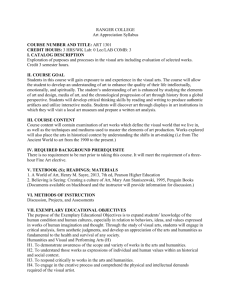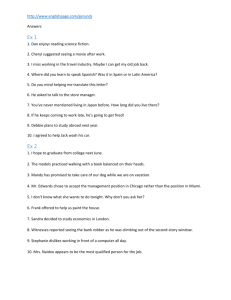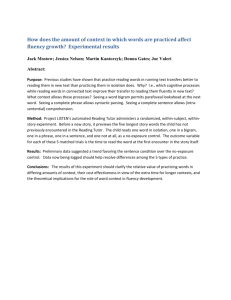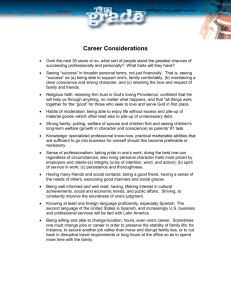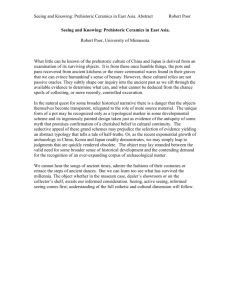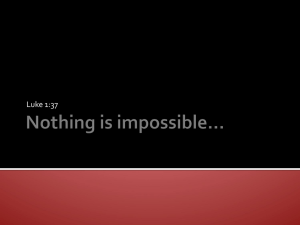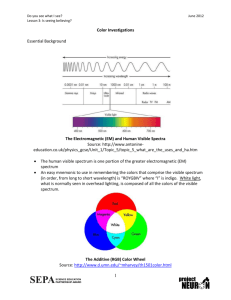"Is Seeing Believing" Sermon Script
advertisement
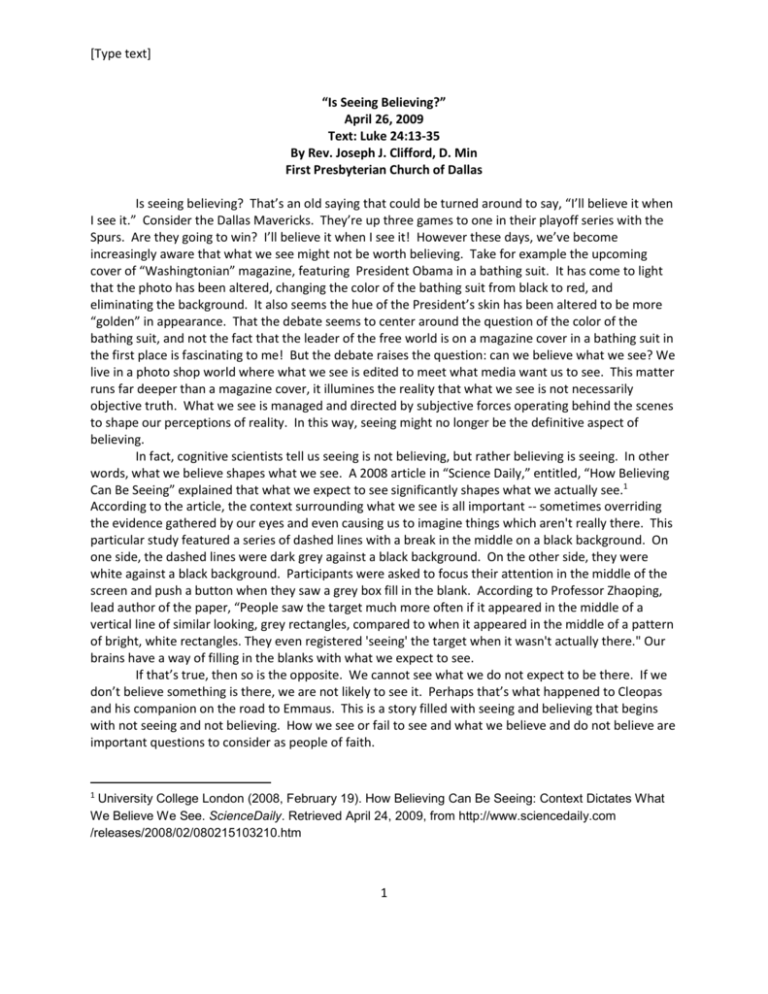
[Type text] “Is Seeing Believing?” April 26, 2009 Text: Luke 24:13-35 By Rev. Joseph J. Clifford, D. Min First Presbyterian Church of Dallas Is seeing believing? That’s an old saying that could be turned around to say, “I’ll believe it when I see it.” Consider the Dallas Mavericks. They’re up three games to one in their playoff series with the Spurs. Are they going to win? I’ll believe it when I see it! However these days, we’ve become increasingly aware that what we see might not be worth believing. Take for example the upcoming cover of “Washingtonian” magazine, featuring President Obama in a bathing suit. It has come to light that the photo has been altered, changing the color of the bathing suit from black to red, and eliminating the background. It also seems the hue of the President’s skin has been altered to be more “golden” in appearance. That the debate seems to center around the question of the color of the bathing suit, and not the fact that the leader of the free world is on a magazine cover in a bathing suit in the first place is fascinating to me! But the debate raises the question: can we believe what we see? We live in a photo shop world where what we see is edited to meet what media want us to see. This matter runs far deeper than a magazine cover, it illumines the reality that what we see is not necessarily objective truth. What we see is managed and directed by subjective forces operating behind the scenes to shape our perceptions of reality. In this way, seeing might no longer be the definitive aspect of believing. In fact, cognitive scientists tell us seeing is not believing, but rather believing is seeing. In other words, what we believe shapes what we see. A 2008 article in “Science Daily,” entitled, “How Believing Can Be Seeing” explained that what we expect to see significantly shapes what we actually see.1 According to the article, the context surrounding what we see is all important -- sometimes overriding the evidence gathered by our eyes and even causing us to imagine things which aren't really there. This particular study featured a series of dashed lines with a break in the middle on a black background. On one side, the dashed lines were dark grey against a black background. On the other side, they were white against a black background. Participants were asked to focus their attention in the middle of the screen and push a button when they saw a grey box fill in the blank. According to Professor Zhaoping, lead author of the paper, “People saw the target much more often if it appeared in the middle of a vertical line of similar looking, grey rectangles, compared to when it appeared in the middle of a pattern of bright, white rectangles. They even registered 'seeing' the target when it wasn't actually there." Our brains have a way of filling in the blanks with what we expect to see. If that’s true, then so is the opposite. We cannot see what we do not expect to be there. If we don’t believe something is there, we are not likely to see it. Perhaps that’s what happened to Cleopas and his companion on the road to Emmaus. This is a story filled with seeing and believing that begins with not seeing and not believing. How we see or fail to see and what we believe and do not believe are important questions to consider as people of faith. 1 University College London (2008, February 19). How Believing Can Be Seeing: Context Dictates What We Believe We See. ScienceDaily. Retrieved April 24, 2009, from http://www.sciencedaily.com /releases/2008/02/080215103210.htm 1 [Type text] Cleopas and his companion had seen many things in recent days. They saw the events surrounding Jesus of Nazareth. They saw he was a prophet mighty in word and deed before God and all the people. They saw their chief priests and leaders hand him over. They saw him condemned to death. They saw him crucified. They saw their hopes and dreams dashed with his death. They could not see that the stranger walking with them was in fact the risen Lord. Luke tells us, “their eyes were kept from recognizing him.” The Greek word translated “recognized” is epignoskow. It’s made up of two words, gnosis, meaning knowledge, and epi, a preposition with three pages dedicated to it in the Greek lexicon. It can mean around, in front, on, about. It can mean just about any preposition in our language. In this case, epi would mean about or around. In Greek, to recognize is literally to know about. Recognizing represents the intersection of sight and belief. To fail to recognize is not only to not see, it’s to not know, to not know about. Their eyes were kept from knowing about him. What kept them from this sight and belief? If I were a cognitive scientist, which I’m not, but our member, Dr. Sandy Chapmann is, and she tells me I’m on the right track, I would say they could not see because they did not believe it possible that it could be Jesus standing there. Some women had told them about an empty tomb and a vision of angels, some men went to check it out, but they didn’t see anything. If they didn’t see, how could Cleopas and his companion see? They did not see, so they did not believe. And because they did not believe, they could not see Jesus standing right there. Their eyes were kept from recognizing him, from knowing about him, knowing he was there in front of them. What changes this? What moves them toward seeing and recognizing? It begins with what a friend of mine once described as “the Holy dope slap.” “Fools!” says the stranger. “You’re a little slow on the uptake, aren’t you? Haven’t you read the Bible? God’s chosen ones have always suffered. Look at the Israelites! Have they ever not suffered? Look at Moses, all he went through to deliver the people. What thanks did he get? The people always grumbled about him, complaining about his leadership. He didn’t even get to go into the Promised Land! Look at the prophets: Elijah was constantly harassed by Ahab and Jezebel; Jeremiah was imprisoned and eventually executed; Isaiah was a suffering servant if there ever was one; Daniel found himself in the lion’s den! All of them beaten, scourged, imprisoned, many killed; all of them God’s chosen ones. Why would you think the Messiah would be any different?” Luke doesn’t tell us how they responded to Jesus’ holy dope slap. We can imagine what Cleopas might have said. “Well, because we believe it’s a good thing to be God’s chosen ones. We believe to be chosen by God is to be blessed. To be blessed is to be happy, and to be happy is to be successful and respected and wealthy and powerful, and have a bumper sticker on our fancy car that says, “I’m Blessed.” They couldn’t believe that to be God’s chosen one means to suffer at the hands of worldly power and be killed. Therefore they couldn’t believe Jesus was the Messiah. They certainly couldn’t believe God raised him from the dead. And so they could not see him standing there in front of them. Their eyes were kept from recognizing him. But perhaps with Jesus pointing out how the stories of God’s suffering servants pointed to him, perhaps as their beliefs about the blessings of being God’s chosen one began to be challenged, perhaps their ability to see began to change. Their seeing and believing begins to really shift because of their doing. What do they do? They offer hospitality to this stranger they cannot see is the Risen Christ. They invite this alien in and feed him supper. The stranger was moving on, but they invite him to stay with them. “Stay with us, it’s getting late,” or in the Scottish translation from the old hymn, “Abide with me, fast falls the eventide.” Then the stranger-become-guest does something strange. The guest becomes the host. He takes the bread. He blesses it. He breaks it. He gives it to them. And in that doing, suddenly they are 2 [Type text] seeing, seeing for the first time something they remember, something they no doubt saw this One do before, and their eyes are opened, and what they see intersects with that they believe and they recognize him! It’s Jeses! And just as they are wrapping their arms around that, he vanishes from their sight. So it often is with revelations in the life of faith. But they’ll never see things the same way again. They’ll never see that way again because now they believe. And what they believe will redefine what they see, because seeing is believing and they have seen and now they believe, and since believing is seeing, they’ll never see the same way again. And all these shifts in seeing and believing are born from a simple act of doing: inviting the stranger in, sitting down at table with him, seeing him break bread and give it to them. Seeing shapes believing, but believing defines seeing, and doing has a way of reshaping both seeing and believing. Somewhere in seeing, believing and doing, from time to time by the grace of God and the power of the Holy Spirit, we recognize the Risen Lord in our midst! Where mighte we meet the Risen Lord in the midst of our seeing and believing and doing? Somewhere in seeing him come through the line at the Bridge, seeing her offer hospitality with a tray of food or a cup of water and a smile, somewhere in that doing eyes are opened to see in new ways and believe He is risen. Somewhere in working on the roof of a house in Galveston where hopes and dreams have been destroyed by a storm, somewhere in seeing that devastation and believing that those who weep are blessed and in doing something to be that blessing eyes are opened and we recognize him in our midst, and we believe He is risen. Somewhere in sitting with the one in a hospital room, awaiting surgery or preparing for surgery, with those they love whose hopes and dreams are under siege, somewhere in seeing that suffering and knowing that loving and not being able to do much more than the doing of being with in a way that defines love, somewhere in that seeing and believing and doing our eyes are opened, and we believe He is risen. Somewhere in opening the Bible and talking with friends about what we see and what we believe and looking at the world and all the crosses it holds for hopes and dreams, somewhere in all that wrestling with seeing and believing and wondering what we should be doing, somewhere in all that our eyes are opened and all that keeps us from recognizing Him is removed and we see and so we believe and because we believe we see, and so we do, and what we believe changes and so we see things differently and we believe He is risen. What do you see when you look at the world? What do you believe? What do you do? How does what you see shape what you believe? How does what you believe define what you see? How might doing something change all that? How might offering hospitality, sitting at table with a stranger, taking bread broken and given to you, serving at the Bridge; or going to Galveston this summer to be that stranger; or sitting in the hospital with that friend; or opening the Scriptures to see what they say, or being in worship this day to say thank you to the God who gives us our very being, how might doing these things, seeing what we say we believe unfolding in our doing, how might our eyes be opened? Could we find ourselves at the intersection of seeing and believing that is recognizing? Could we find ourselves running seven miles back to Jerusalem, or to Richardson, or to Lake Highlands, or to Kessler Heights or to Highland Park to say, “The Lord has risen! He has risen indeed! We have seen him!” Can you imagine? 3
